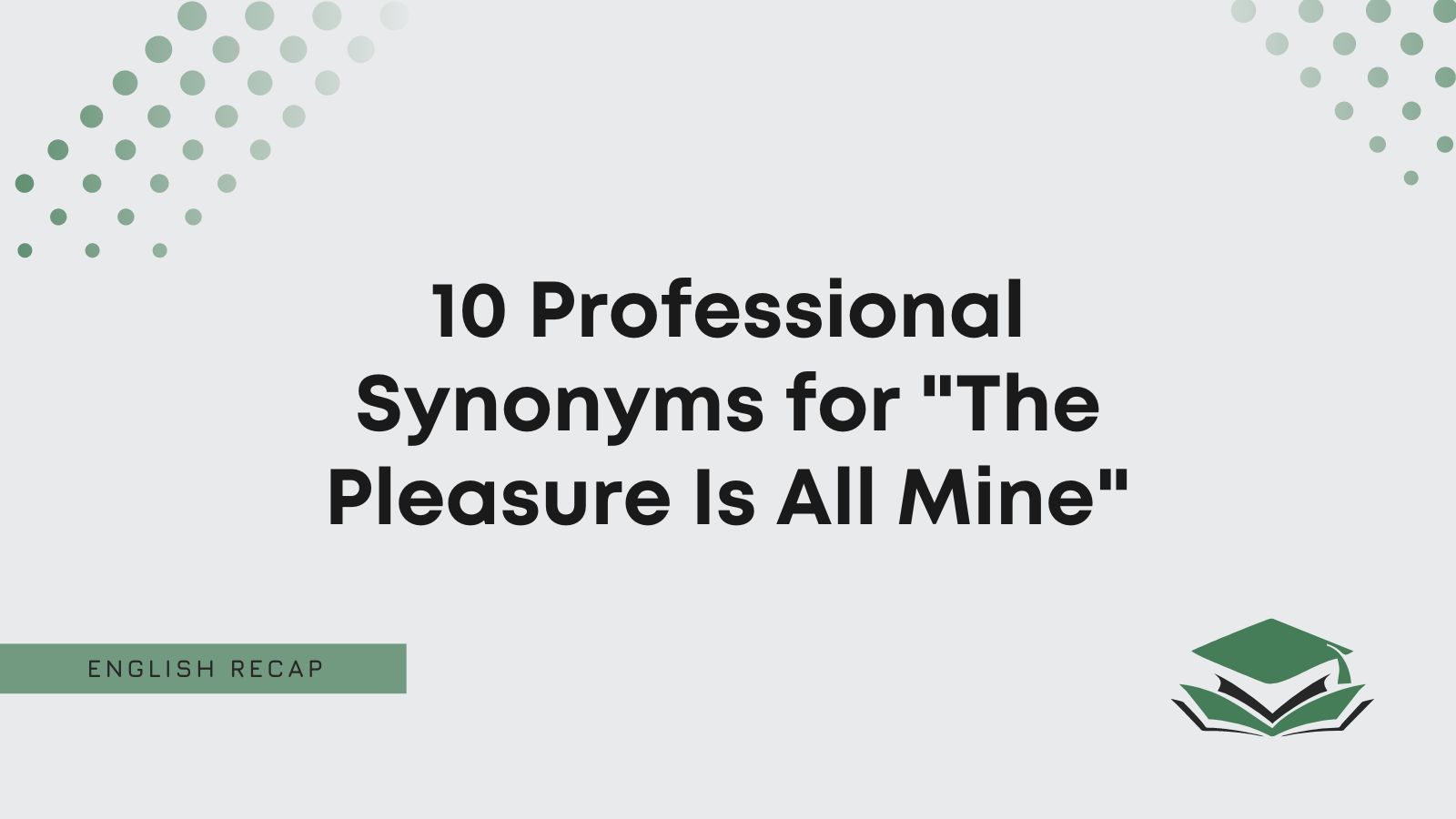It’s great to respond to appreciation in a positive way. When someone says “thank you,” you should reply with a polite gesture such as “the pleasure is all mine.”
Although, “the pleasure is all mine” isn’t the only professional phrase that works. It’s worth exploring some alternatives.
This article has gathered some great options to show you how to say “the pleasure is all mine” in an email.
Is It Professional to Say “The Pleasure Is All Mine”?
It is professional to say “the pleasure is all mine.” It’s useful as a formal phrase when replying to someone’s appreciation email.
It’s similar to saying “no problem” or “you’re welcome.” It’s a great choice if someone says thank you, and you’d like to remain humble and let them know you enjoyed helping them.
Here’s a great example to show you how to use it:
The pleasure is all mine, Barry. Let me know if there’s anything else you’ll need from me in the future.
Pros
- It’s a polite way to accept appreciation.
- It’s personal and shows you were more than happy to help.
Cons
- It’s overused.
- It could be seen as sarcastic in the wrong contexts.
So, “the pleasure is all mine” is one of the best formal phrases.
It’s also worth noting that it’s not the only one. Therefore, you should explore your options to keep your writing fresh.
Keep reading to learn another way to say “the pleasure is all mine.” You can also review each of the examples we provide.
What to Say Instead of “The Pleasure Is All Mine”
- It’s my pleasure
- Don’t mention it
- Not at all
- You’re welcome
- I’m glad I could help
- I’m glad to be of service
- No problem
- I’m pleased you came to me
- I’m honored to assist
- It was no trouble
1. It’s My Pleasure
For a professional way to say “the pleasure is all mine,” try “it’s my pleasure.”
Realistically, it’s just a rewording of the original phrase. However, that doesn’t make it ineffective.
If anything, “it’s my pleasure” is more formal than “the pleasure is all mine.” After all, it’s fewer words and is more concise, making it sound more respectful.
You should try it when replying to customers. It’s a great way to show that you didn’t mind helping them with something.
Feel free to refer to this email example as well:
Dear Mr. Parker,
It’s my pleasure. Thank you so much for coming to me in the first place, as I was honored to be of assistance.
Yours,
William Terrance
2. Don’t Mention It
Sometimes, it helps to sound more conversational when accepting someone’s appreciation.
Think about it. In normal conversation, if someone says “thank you,” you might say “no problem” or “you’re welcome.” There’s nothing wrong with bringing a more conversational phrase to an email.
In this context, why not try “don’t mention it”?
It’s slightly more informal, but it works well in business emails to coworkers. It shows you’re happy to help them and want them to understand that you’re approachable if they need you.
You can also review this example:
Dear Christina,
Don’t mention it! I’m really happy to see that you’re making progress in this field. Let me know what else you learn.
Yours,
Greta Mouths
3. Not at All
You can also write “not at all.” It’s slightly less direct than “the pleasure is all mine,” but it’s still a great way to humbly accept appreciation.
We recommend writing “not at all” when you think you don’t need to be thanked. Sometimes, you help someone or complete a task because you want to, not just because someone asks you.
Therefore, “not at all” is great when you’re happy to help. Think about using it the next time you reply to a client. It shows you’re happy to assist them, regardless of what they need.
Check out the following sample email if you’re still stuck:
Dear Ms. Carter,
Not at all. You do not have to thank me for something as simple as this. To be honest, I was more than happy to do it.
All the best,
Holly Anna
4. You’re Welcome
When covering a list of synonyms to reply to “thank you,” you can’t go wrong with “you’re welcome.”
It’s one of the most common and useful ways to appreciate someone’s thank-you message.
“You’re welcome” might seem a little more conversational, but that doesn’t mean it’s ineffective.
If anything, it’s a great phrase to include in an email because it’s conversational. It’s a recognizable phrase that shows you accept someone’s gratitude.
Also, this example will help you with it:
Dear Thomas,
You’re welcome! I’m more than happy to chip in and offer assistance when I’m needed. I’m only an email away.
Best wishes,
Dean Smythe
5. I’m Glad I Could Help
If a customer has thanked you for helping them, you should be respectful and polite. Your reply should come from a sincere place and be positive.
The more positive you are, the more likely a customer will return. So, try “I’m glad I could help.”
“I’m glad I could help” works well when replying to customers. It’s friendly and genuine, showing you appreciate the chance to help someone.
It’s also a really kind way to accept someone’s thank-you message. Most recipients will be happy to receive a reply like this.
Here’s a great example to show you how it works:
Dear Ms. Timone,
I’m glad I could help you with this issue. Hopefully, this is the last time something like that will happen to you.
Best regards,
Jon Adams
6. I’m Glad to Be of Service
You should include “I’m glad to be of service” as a more formal synonym for “the pleasure is all mine.” It works well in professional emails to show you’re happy to help.
Typically, this works when helping clients. It’s great because it allows you to remain formal while suggesting you’re always happy to provide for your clients.
Clients prefer working with companies that appear friendly and helpful. That’s why you’ll have a lot of luck using this in your emails.
The following example will also help you:
Dear Mr. Clarkson,
I’m glad to be of service. After all, I’m here to assist you whenever you have any queries.
Kind regards,
Mat Bleak
7. No Problem
Another common way to accept gratitude is “no problem.” Therefore, when someone thanks you in an email, you should try “no problem” to see if it’s a good fit.
While it’s a common choice, it’s still formal. It’s great to include in emails when you’re grateful to see that someone is happy with what you’ve done for them.
Also, saying “no problem” implies you did not mind helping someone. It’s great if you’re trying to remain friendly and approachable in case they need you again in the future.
This email sample should clear a few things up:
Dear Alexander,
No problem. Please let me know how it goes when you give this project to your manager. I’m sure they’ll like it.
All the best,
Freya Harding
8. I’m Pleased You Came to Me
Here’s a slightly more interesting way to accept someone’s “thank-you” email. You can say “I’m pleased you came to me.”
It’s good in formal settings. It shows you’re happy someone relied on you. Also, it acts as an alternative to “the pleasure is all mine” because it shows you’re still pleased that you were asked.
We recommend using it when emailing customers back. It shows you’re happy they approached you with a problem, especially if you found an effective solution for it.
You can also refer to this sample email:
Dear Ms. Harris,
I’m pleased you came to me for help. Let me know if there’s anything else I can do because I’m always happy to be there for you.
Yours,
Tom Washington
9. I’m Honored to Assist
A great respectful alternative to “the pleasure is all mine” is “I’m honored to assist.”
It works well when you want to show genuine respect to the recipient after they thank you.
For instance, you can use it when emailing your boss. It shows you’re keen and willing to help when they need you.
The happier you are to help your boss, the more likely they’ll be to depend on you. That’s why we recommend using this if you’re trying to get into their good books.
We also recommend reviewing the following email example:
Dear Adrian,
I’m honored to assist. Feel free to come to me any time if you need anything else.
Yours,
Joey Magnar
10. It Was No Trouble
You can also try “it was no trouble” as a more friendly way to accept gratitude.
It shows you did not mind helping someone and went through no trouble to complete a task for them.
This is a great way to build a positive relationship. It shows you were happy to go out of your way for someone.
It also shows you’re more reliable than someone might have thought. So, it helps you to stand out to them, and they may rely on you again in the future.
You should review this sample email to see how it works:
Dear Toby,
It was no trouble. I’m just glad you managed to find a way to complete the task without any issues.
All the best,
Jackson Martinez

